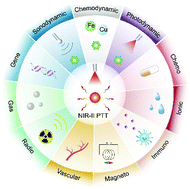Second near-infrared photothermal materials for combinational nanotheranostics
Abstract
Second near-infrared photothermal therapy (NIR-II PTT, 1000–1500 nm) has recently emerged as a new phototherapeutic modality with the advantages of deeper penetration, less energy dissipation and minimal normal-tissue toxicity over traditional first NIR PTT (750–1000 nm). However, suboptimal photothermal conversion and limited therapeutic efficacy remain the major challenges for NIR-II PTT. With the convergence in materials science, nanomedicine and biology, multifunctional NIR-II photothermal inorganic or organic materials have been extensively developed to combine NIR-II PTT with other therapeutic modalities for improved efficacies in treating life-threatening diseases including cancer and infection. This review summarizes the recent advances of NIR-II photothermal combinational theranostics pertinent to chemotherapy, immunotherapy, radiotherapy, and photodynamic, sonodynamic, chemodynamic, gene, gas, ionic, vascular and magnetothermal therapy. Potential obstacles and perspectives for future research and clinical translation of this new theranostic modality are also discussed.



 Please wait while we load your content...
Please wait while we load your content...